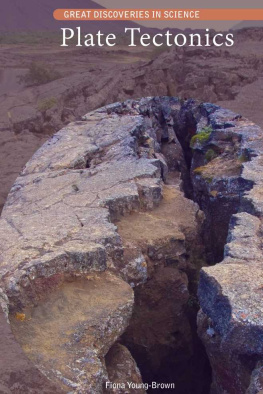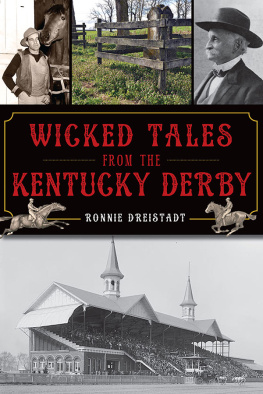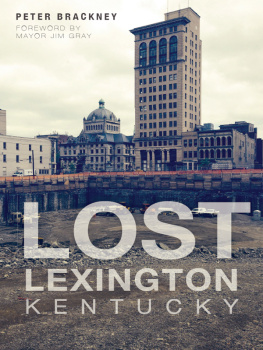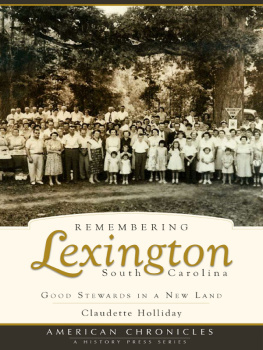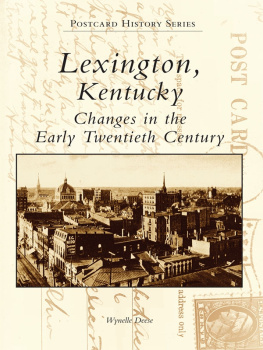

Published by The History Press
Charleston, SC 29403
www.historypress.net
Copyright 2011 by Fiona Young-Brown
All rights reserved
First published 2011
e-book edition 2013
Manufactured in the United States
ISBN 978.1.62584.108.7
Young-Brown, Fiona.
Wicked Lexington, Kentucky / Fiona Young-Brown.
p. cm.
Includes bibliographical references.
print edition ISBN 978-1-60949-133-8
1. Crime--Kentucky--Lexington--History--Anecdotes. 2. Violence--Kentucky--Lexington--History--Anecdotes. 3. Corruption--Kentucky--Lexington--History--Anecdotes. 4. Scandals--Kentucky--Lexington--History--Anecdotes. 5. Lexington (Ky.)--Moral conditions--Anecdotes. 6. Lexington (Ky.)--Social conditions--Anecdotes. 7. Lexington (Ky.)--Biography--Anecdotes. I. Title.
HV6795.L48Y68 2011
364.10976947--dc23
2011019690
Notice: The information in this book is true and complete to the best of our knowledge. It is offered without guarantee on the part of the author or The History Press. The author and The History Press disclaim all liability in connection with the use of this book.
All rights reserved. No part of this book may be reproduced or transmitted in any form whatsoever without prior written permission from the publisher except in the case of brief quotations embodied in critical articles and reviews.
CONTENTS
ACKNOWLEDGEMENTS
I would like to thank several people for their help in putting together Wicked Lexington, especially Will McKay at The History Press, Amanda Hervey and Sarah Katzenmaier. Thanks also to Eric Brooks and the staffs at the Lexington Public Library, the University of Louisville Law Library and the University of Kentucky Archives. As always, I am grateful to my husband, Nic Brown, for his continuing support and his willingness to read drafts.
Perhaps most importantly, I am forever grateful to my grandmother, Florence Curtis, for instilling in me at a young age a love of gossip about all things wicked. Rest in peace.
INTRODUCTION
The people of Lexington have long prided themselves on their city, and for good reason. They are fortunate to live in the heart of horse country, in a college town that has produced major statesmen, a First Lady, Civil War heroes, Nobel Prize winners, artists and many more notable residents. As one drives through the gently rolling fields of the horse farms, past the historic houses of a genteel past and into the downtown area, one cannot help but sense a certain amount of southern charm. But does something else lie beneath that proper exterior? Something wicked perhaps?
For the first half of the nineteenth century, Lexington was a city ahead of its time, a leader in the fledgling push for westward expansion. In 1779, a party of twenty-five men built a fort at Town Branch, what is now the corner of Main Street and Mill Street. Twelve men and one woman remained in the fort, a small affair of four cabins. At night, they could hear local Indians outside. The following year, despite a brutal winter that left food scarce and many animals dead, Fayette County came into being, and the pioneers and founding fathers of Kentuckys commonwealth trickled into the new wilderness. Among the first settlers of the town were Levi Todd, whose granddaughter, Mary, would one day become First Lady of America, and Colonel Robert Patterson, who would later head north to be one of the founders of Cincinnati. Growth of the fledgling city was slow at firstIndians, climate and the difficulty of clearing the land were all contributing factors. Merchants began to open shop in 1784, and settlers established farms in the outlying areas. Hemp and tobacco were grown, and whiskey was distilled.

The fort at Town Branch in 1792the beginnings of Lexington. Courtesy of Lexington History Museum.
Perhaps there was already a hint of wickedness as far back as 1780that is when the first jail was built. Within ten years, the need for a holding place had outgrown the small wooden hut, and a stone building replaced it. This, in turn, was replaced by a larger jail in 1819. The earliest crimes were what one might expect of any frontier town: gambling and brawlingalthough the brawling would not resemble any drunken fight we might happen upon today. Kentucky wrestling incorporated the use of knives and a range of techniques designed to maim the opponent: eye gouging, ear biting and testicle wrenching! Foreign visitors to the region were horrified by the level of everyday violence they encountered. Life on the frontier was rough, and the people who settled it displayed a degree of toughness that shocked a more genteel world.
One only has to recall the story of the towns first schoolmaster as an example of the ruggedness required in those early days. John McKinney began teaching lessons to the pioneer children in 1783 in a small log schoolhouse. One morning, a wildcat leapt through the schoolhouse door and onto the unsuspecting teacher. With its fangs dug into his ribs, McKinney found that no help was coming and so did what anyone would do in such a situationhe proceeded to strangle the cat to death and then removed the fangs from his bleeding torso. (Although, one could argue that a tougher man might not have canceled school for the day). This was a land where even the teachers had to be ready for anything. But in time, as Lexington expanded, the frontier moved toward the horizon. The city took on that veneer of polite society, and brawling evolved into the more gentlemanly art of dueling.
Churches formed, as did a newspaper in 1787. Although the Town Branch often flooded, spilling over its banks into the center of the town, the residents looked past such inconveniences and forged ahead. Then, in 1793, Transylvania Seminary decided to relocate permanently to Lexington. A few years later, it adopted university status. The presence of what would be one of the finest universities in the nation in the nineteenth century was a boon to Lexington and helped put it on the path to being an educational and cultural capital. With the later establishment of medical and law schools at Transylvania, Lexington went from being a small fort with thirteen occupants to the Athens of the West, a booming center of expansion with seven thousand residents by 1833.
Lexington quickly established itself as a center of commerce. Wool factories and paper mills were constructed on what is now Manchester Street. Traders set up shop. The town prospered. Yet things did not always progress smoothly. James Prentiss, who came to Lexington in 1805 from New England to establish the paper mills, fled the town in disgrace in 1817, guilty of fraud and facing financial ruin. A Yale-educated Bostonite by the name of J.B. Borland found life in Kentucky too depressing, and in 1815 he slit his throat and jumped to his death. Such events were part of life anywhere, and Lexington was no exception. Entrepreneurs such as John Wesley Hunt helped the city to grow, both economically and politically. A number of prominent families contributed to the development of banks, business and more. Many of these names are noted around Lexington today: Hunt, Gratz, Breckinridge and Clay.
By the 1830s, Lexington not only had a university, it also had a railroad, fire stations, hotels and a state-of-the-art mental institution, one of only two in the nation. An orphanage was opened after the cholera epidemic of 1833, and the first city school was opened in 1834, offering education to the poor.
Next page



